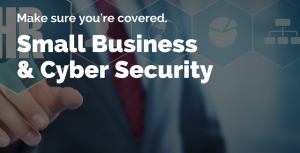Most enterprise level corporations have more sophisticated protection against serious risks than most small businesses. Nonetheless, it’s critical to protect your business – no matter how great or small – and here’s a list of basics to get you started.
Software & Security Patch Updates
Updates are released for software all the time. It’s important to stay up-to-date as older versions may become unsupported by the manufacturer, require patches for unsecure code, or eventually become defective. Hiring a responsible Information Technology company or internal talent is also crucial. It is possible for errors or security breaches to occur while installing patches and updates.
Passwords
Keep your list of passwords guarded heavily in a password-protected document placed where only you and your IT company, or internal talent have access. Many of your desktop/laptop profiles are set to prompt you periodically to change your password. Ensure your password has a high strength rating that includes a combination of uppercase, lowercase, alphanumeric characters and symbols. Don’t use the same password for everything. Try to avoid standard passwords for a login for common internal computers. If this cannot be avoided, make sure it’s gated and incredibly secure.
Web Surfing
There’s plenty of social networking and e-commerce sites that maintain a healthy content flow. Remember when all the Snapchats were leaked? A good rule of thumb is to know that no place on a digital platform is TRULY safe protected. With this in the back of your mind, be mindful about what you post, links you click, and sites you visit to help minimize risk.
Scams
The number of scams that are popping up and targeted at technology platforms and digital channels is alarming. Be vigilant about false tracking numbers, invoices, and phishing emails. Scammers are becoming more creative in how they can obtain, use, and sell your information. Easy ways to identify scams when they look legitimate are to:
- Look at the hyperlink if it’s driving you to a different site (scam hyperlinks will likely point some place else besides the actual company’s site)
- Look for spelling and grammar. If it’s a scam, it will likely give itself away with misspellings or grammatical errors.
- If it’s difficult to tell, consult with your IT department.
WIFI
Your network is secured with a password. Take it one step further and have a Guest Login and an Internal Login for normal business activity and operations. Both WIFI access points should be protected with different passwords, and only the guest password should be distributed to visitors. It is also highly advised to periodically change your passwords.
Anti-Virus
It is very common for an office to have some form of anti-virus and internet security. If you are a small business who practices do-it-yourself research, it’s wise to employ an IT consultant to help you figure out the best software. Not all internet protection is created equal.
If there’s a questionable file or site, don’t download or open it. You can always find sites online like https://www.virustotal.com/ that you can enter a URL or file to run it through their tests.
Theft
Employees may be exposing your company to potential information theft without knowing that they are doing so. If employees are writing down passwords and posting them at their desk or forgetting them, keeping them in a public place, or actually losing their hardware, this creates a giant security risk. If someone infiltrates your office or laptop, they’ve found a goldmine of easily accessible confidential information. This could be a potential client visiting the office for a consultation to the night cleaning crew. It’s best to keep all passwords on a password protected document such as an excel spreadsheet with access restrictions.
Many of these preventative measures may seem obvious, but this is precisely why so many small businesses overlook them and can end up with a much larger, more expensive problem on their hands. Be proactive in protecting your business’ information.


